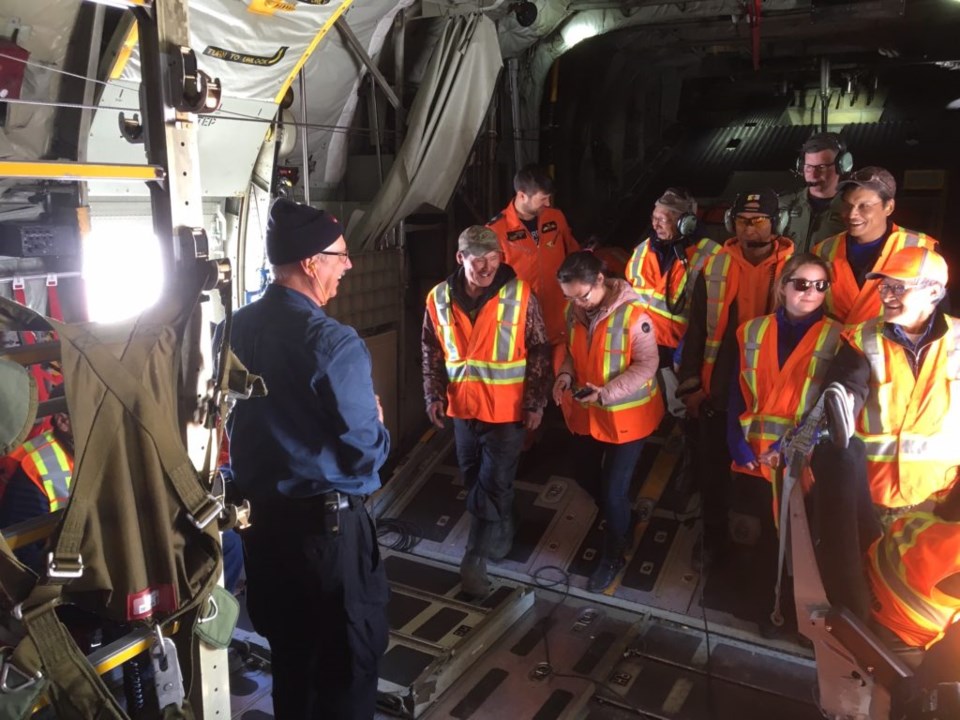
With increasing global warming, there has been an increase in human activity in Canada’s Arctic. When problems arise in remote regions of the Arctic, responsibility for coordinating search resources belongs to Canadian Forces 424 Squadron, based at Trenton, Ontario.
Associated with 424 Squadron are the civilian volunteers of Civil Air Search And Rescue Association (CASARA), a national organization with members in every province and territory, including a unit based at Niagara District Airport. With the two organizations training together from time to time, this explains why you might notice a large, dark green, aircraft (C-130 Hercules), or the smaller yellow helicopter (CH-146 Griffon), flying around Niagara Region.
Having volunteered for a number of years as a member and training officer of the Niagara search and rescue team, I was recently honoured to participate in a training mission to Arctic communities.
On May 28, I met up with three other volunteer search and rescue colleagues, and the 424 Squadron crew of a Hercules aircraft for the flight north, from Trenton to Kuujjuaq, Quebec. Kuujjauq is an Inuit community at the north eastern part of Quebec, along the large Koksoak River, near Ungava Bay, leading to Hudson Strait. This area is an entry point for ships traveling to and from the Northwest Passage; hence the need for local search and rescue resources. Our task was to train local volunteers in spotting those in need from an aircraft.
When we arrived at the airport terminal we met the Northern CASARA director, who arrived from Iqaluit, but none of the other volunteers had arrived for training.
Rule number one on a training mission: “Be adaptable to changing circumstances.”
There had been a misstep in communications, so it was decided to conduct a training flight with those of us who were available. Unlike countryside around Niagara, which is fully inhabited, beyond the community of Kuujjuaq, it was tough to identify objects on the ground to call targets, which could be described and confirmed by the flight crew. When my turn at the window came, I spotted a small building along the shores of Koksoak River. Using the appropriate commands, I was able to communicate to the pilot to have the Hercules circle around, to fly over the building a second time for all the crew members to identify the object I was observing.
Before we landed back at Kuujjuaq, the Search and Rescue Technicians (SARTechs), dropped several parachute bundles of simulated rescue equipment from a low altitude at the far end of the airport. Then the Hercules climbed high to allow the SARTechs to do a free fall parachute jump. It’s always a thrill to have a close up view of SARTechs jumping from the rear of the Hercules.
The next day of the mission we flew north across Baffin Island to Pond Inlet, Nunavut. During transit flights there is always training of some sort taking place. On the way to Pond Inlet a simulated training session took us through Auyuittuq National Park, to search for hikers who had not been heard from in two days. The simulated search area was at the base of Thor Peak, which has the world’s longest (4,100 feet) vertical drop. With prior (required) permission from Ministry of Natural Resources, we flew several circles around the granite peak, famous among rock climbers.
Arriving at Pond Inlet, we were met by an enthusiastic group of local Inuit CASARA volunteers. After a spotter training session and flight briefing at the airport terminal, the group flew a training mission over nearby mountains. The value of volunteers supporting Canadian Forces in search and rescue is the local knowledge they contribute for effective and successful search missions. Particularly in the Arctic, Inuit volunteers are experts in knowing where lost people may be located, and what signs to look for.
During our flight training, the air commander had been in contact with personnel at our next intended stop, Resolute Bay. Resolute had been experiencing snow and freezing rain, which prevented aircraft from landing or taking off. The decision was made for us to return to Kuujjuaq for the night, and re-evaluate our next assignment.
As we flew south, across Baffin Island, I marveled at the beauty of the Arctic landscape. I also pondered how, historically, Europeans could assume ownership rights of such vast lands with a document entitled, Doctrine of Discovery. Much of what southerners consider Canadian Arctic is identified on maps as “Inuit Owned Lands.”
Having arrived late at night a second time in Kuujjuaq, the start of our third day was delayed for a much-needed rest. When we gathered at the airport, we were met by a group of local CASARA volunteers. Instruction on spotting and flight briefing were again conducted, prior to a training flight. Again, it was evident local knowledge is valuable to identify land marks or objects not readily visible to others.
Contacts to Gjoa Haven and Rankin Inlet confirmed poor weather conditions, cancelling our plans to conduct training there. Meanwhile, the active search and rescue Hercules at Trenton had been called to evacuate members of a community in northwestern Ontario, threatened by wildfire. Our aircraft was needed back at Trenton to be on standby for further operations.
With weather conditions always a major factor in Arctic travel, our mission of training two out of five communities was considered a success. The goal is to have members of northern communities trained to promptly and effectively launch rescue operations when the need arises.
As a member of CASARA, the local organization is known as Civil Air Rescue Emergency Service (CARES) Niagara. A registered charity, CARES relies on donations to operate its training facility, vehicle and aircraft. For information, or to volunteer, contact <[email protected]> or ontario.casara.ca.